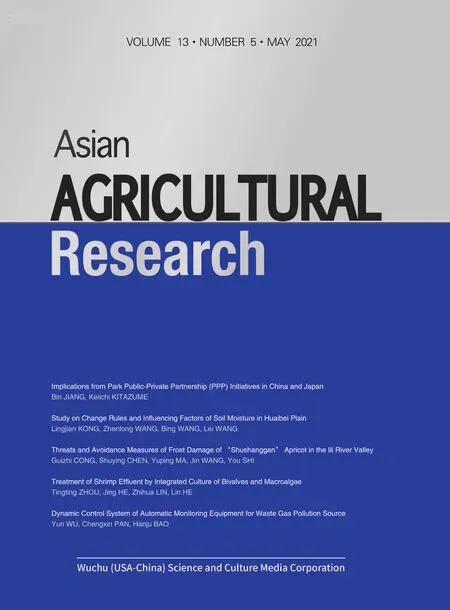Treatment of Shrimp Effluent by Integrated Culture of Bivalves and Macroalgae
2021-07-21TingtingZHOUJingHEZhihuaLINLinHE
Tingting ZHOU, Jing HE, Zhihua LIN, Lin HE
Ninghai Institute of Mariculture Breeding and Seed Industry, Zhejiang Wanli University, Ningbo 315604, China
Abstract [Objectives] To provide a theoretical basis for constructing the best species suitable for local shrimp-bivalves-algae IMTA through the screening of different bivalves and the determination of seaweed density. [Methods] The preliminary studies of different kind of bivalves and macroalgae (Gracilaria lichevoides) used for the purification of shrimp effluent were described. Through the screening of benthic bivalves, the best ratio of integrated culture of bivalves and algae was determined. [Results] Both bivalves and macroalgae had certain purification effects on aquaculture wastewater, but the effects significantly differed from species and breeding density. The removal rate of nutrient declined from Potamocorbula laevis, Sinonovacula constricta, Tegillarca granosa. The mixotrophic culture of 8 ind/L P. laevis and 120 g G. lichevoides had the highest efficiency of purification and removal rates of nutrient: NH4-N: 90.67%, TP: 86.18%, TN: 72.66%, NO3-N: 51.85%, respectively. There was a significant difference between the blank control group and the other three groups (P<0.01). The 8 ind/L+120 g group was significantly higher than the 4 ind/L+120 g group (P<0.05) in TP removal rate. Additionally, the difference between four groups was significant in the removal rate of NH4-N and TN (P<0.05), but 2 ind/L+120 g group and 8 ind/L+120 g group in the removal rate of NO3-N had no significant difference (P>0.05). [Conclusions] This research provides a reference for the use of filterable shellfish and large seaweed to treat aquaculture wastewater, and also provides the theoretical basis for constructing the local multi-level breeding structure.
Key words Filter-feeding bivalves, IMTA, Gracilaria lichevoides, Aquaculture wastewater, Purification effect, Removal rate
1 Introduction
Aquaculture is playing a more and more important role in China’s agricultural economy. With the continuous increase of industrialization and high-density aquaculture, the eutrophication of aquaculture wastewater is also increasing. In recent years, with the proposal and implementation of some water pollution control policies in Zhejiang Province including "five-water co-governance", and elimination of inferior V-type water, mariculture is also facing an important transformation, from extensive high-density aquaculture to eco-friendly aquaculture. At present, aquaculture industries involving soft-shelled turtle and bullfrog, which carry out extensive management, have been banned. With the promotion of environmental protection policy, high-density shrimp culture is bound to face industrial upgrading and wastewater treatment. Therefore, it is necessary to find a way for the sustainable development of the aquaculture industry in line with the local reality.
Integrated multi-tropic aquaculture (IMTA) is a multi-nutrient-level integrated culture system formed by many species. It appropriately blends fish, shrimp, plankton, benthos and algae for culture to facilitate the conversion of wastes discharged by high-nutrient-level cultured organisms into products of low-nutrient-level cultured organisms with economic value. Through the comparative study between the experiment in the laboratory or outdoor pond and the monoculture control group, it is found that the integrated culture at multi-nutrient levels can not only greatly reduce the discharge of wastewater, increase the biological species in the culture water, and maintain the ecological balance of the culture system, but also promote the growth of culture varieties and the energy flow and material circulation in the culture water environment. There are dual or multiple integrated culture models including fish-shrimp-bivalves, shrimp-crab-algae, shrimp-bivalves. The research on the integrated culture model at multi-nutrient levels, such as shrimp-bivalves-algae, has become a hot spot at present. However, the physiological structure and external growth environment of different bivalves are different, so the long-term adaptation to the environment leads to different feeding behavior, as a result, there are great differences in the filtering effects of nutrients and suspended solids in wastewater among different species of bivalves. Macroalgae are the primary producers in the marine ecosystem, which use carbon dioxide, nitrogen, phosphorus and other nutrients for photosynthesis. Large-scale culture of offshore macroalgae can consume a large amount of C, N, P and other elements in the living sea area, changing the material cycle in the sea area, and improving eutrophication of water body,etc.
. However, different algae have different growth habits, contact area with water and metabolic mechanism of organic matter absorption, so the selection of species combination suitable for IMTA is the key to determine the efficiency of IMTA system.Litopenaeus
vannamei
is currently one of the three largest aquaculture varieties in the world.Potamocorbula
laevis
,Tegillarca
granosa
andSinonovacula
constricta
are the most common benthic bivalves in Zhejiang Province.Gracilaria
lichevoides
is also one of the most popular algae species. Through the screening of different bivalves and the determination of algae density, the purpose of this experiment was to provide a theoretical basis for constructing the best species suitable for local shrimp-bivalves-algae IMTA.2 Materials and methods
2.1 Experimental materials
The experiment was carried out in the shrimp culture workshop of the marine and fishery science base in Ningbo with a period of 5 d. The experimental materialG.
lichevoides
was collected in the sea area around Ningbo.P.
laevis
is a wild population collected in Leqing Bay, Wenzhou City.S.
constricta
andT.
granosa
were purchased from the artificial culture area of Xianxiang Town, Ningbo City, and brought back to the laboratory to select healthy and energetic individuals to be domesticated indoors using wastewater. The experiment was carried out in 100 L white polyethylene plastic bucket, using shrimp aquaculture wastewater in greenhouse.2.2 Determination of suitable culture density of algae
In the static experiment,G.
lichevoides
was cultured in 4 density groups with 3 replicates in each group, and the culture density was 0.5, 2.0 and 4.0 g/L, respectively. In addition, a blank control group was set. Before the experiment, the dirt on the algae surface was cleaned, and then the moisture on the algae surface was sucked dry with absorbent paper and weighed. DO: 6.83-7.37 mg/L, salinity: 25, water temperature: 25.0-25.3 ℃. TN: 4.01-4.45 mg/L, TP: 0.56-0.65 mg/L, NH-N: 1.56-2.19 mg/L and NO-N: 0.35-0.76 mg/L, continuous aeration was adopted, and water was not changed during the experiment. Natural light was used as light, and samples were taken from 8: 30 to 9: 00 every day.2.3 Screening of bivalves and determination of culture density
Three kinds of common bivalves were used in the experiment:P.
laevis
,S.
constricta
andT.
granosa
. Indoor domestication was carried out before the experiment,P.
laevis
was a wild population, and a large number of deaths occurred at the initial stage of artificial culture, so after domestication for one month, the experiment was carried out after it was domesticated with different proportions of seawater and wastewater for 7 d withT.
granosa
andS.
constricta
indoors. The experiment was carried out in a 100 L white polyethylene plastic bucket. According to the living habits of three species of bivalves in nature, (7±2) cm thick sediment was put into the culture bucket ofT.
granosa
andS.
constricta
respectively, and (7±2) cm thick sediment (fine sand∶sediment=2∶1) was put into the culture bucket ofP.
laevis
. The sediment was pretreated by exposure to eliminate unfavorable microorganisms. 50 L greenhouse shrimp aquaculture wastewater was injected into three kinds of bivalves culture buckets.Three species of bivalves were divided into 4 culture density groups with 3 biological replicates in each group (Table 1). Through literature review and pre-experiments, the bivalves culture gradient was set. Because of its different size, the culture density was also different. According to the best culture density, the bivalves with the best nutrient salt removal rate were selected. The culture density ofP.
laevis
was set to 100, 200 and 400 ind; the culture density ofT.
granosa
was set to 20, 30 and 50 ind; the culture density ofS.
constricta
was 13, 20 and 32 ind. In addition, a blank control group (BCG) was set. Before the experiment, the stains on the shell were cleaned up, and the shell width, shell length and shell height were measured. During the experiment, continuous aeration was carried out without changing water, and the natural light was used. The experimental period was 5 d, and samples were taken at 8:30 every morning. After the experiment, the dry weight was measured.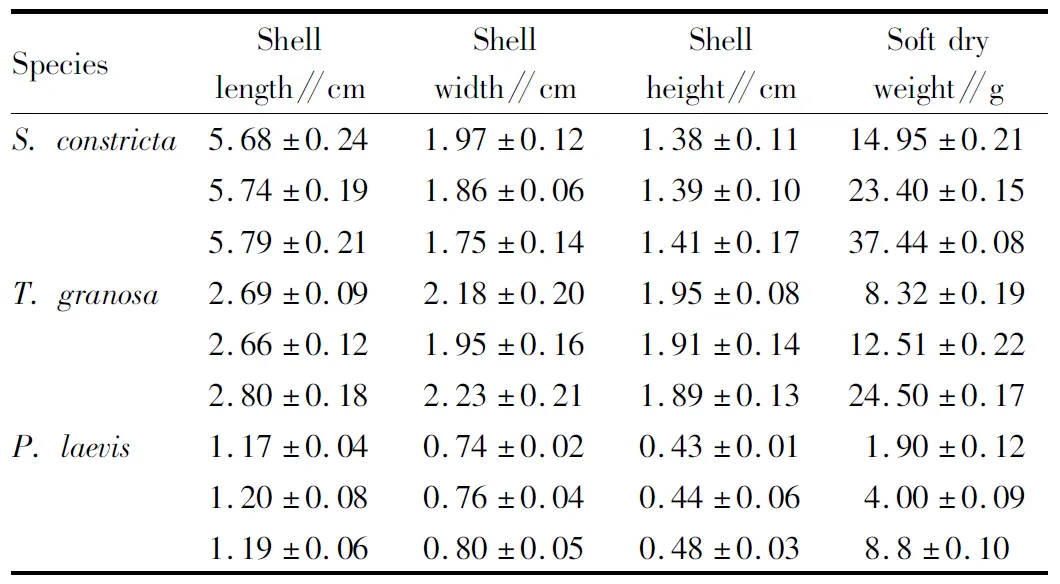
Table 1 Shell length, height and weight of the bivalves used in experiment
2.4 Integrated culture of bivalves and algae
The algaeG.
lichevoides
and bivalvesP.
laevis
, which had the strongest purification ability, were selected for integrated culture for one week, and the other materials were the same as above. 60 L of wastewater from shrimp culture was put into each barrel.G.
lichevoides
andP.
laevis
were mixed with different density. 3 culture density groups and one blank control group were set, and each group had 3 replicates. In each density group, 120 g ofG.
lichevoides
was mixed with 2, 4 and 8 ind/LP.
laevis
. The surface of the two was cleaned before the experiment, and their wet weight was measured. The average wet weight ofP.
laevis
was (0.24±0.03) g.2.5 Water quality monitoring
Nitrate (NO-N), ammonia nitrogen (NH-N), total nitrogen (TN), total phosphorus (TP) and other indicators were selected for water quality detection. Water sample collection method: one water sample was collected at each sampling point (50 mL), the sampling bottle was immersed under the water, the bottle was washed once, the water body was stirred, the foam on water surface was removed, and the middle part of the water sample was quickly taken, then the sampling bottle was put into a dark plastic bag and brought to the laboratory.The water quality monitoring method is based on the marine monitoring code. NH-N: the standard method of DIN and ISO; TN: hydrazine sulfate reduction method; NO-N: zinc-cadmium reduction method; TP: TNTP was combined with Mo-Sb Anti-spectrophotometry, dissolved oxygen meter (YSI) was used to determine salinity, dissolved oxygen and temperature in water during the experiment.
The formula for calculating the removal rate (η
) of each substance is as follows:η
= (C
-C
)/C
×100whereC
is the average concentration of inflow water quality index, andC
is the average nutrient salt concentration of the experimental group.2.6 Data analysis methods
The experimental results are expressed by mean±tandard deviation, and Excel 2007 was used to make charts. The effects ofG.
lichevoides
with different density, three kinds of bivalves and integrated culture of bivalves and algae on the removal of a certain nutrient salt were compared, SPSS 19.0 was used for one-way analysis of variance (one-way ANOVA), andLSD
was used for statistical test (P
<0.05).P
<0.01 means the difference is extremely significant,P
<0.05 means the difference is significant,P
>0.05 means the difference is not significant.3 Results and analysis
3.1 Results of determining the density of
3.1.1
Removal effect ofG.
lichevoides
with different density on NO-N. The removal rate of NO-N inG.
lichevoides
with the culture density of 0.5, 2, 4 g/L and blank control group was 30.93%±3.57%, 36.89%±10.1%, 55.24%±10.7% and -27.13%±5.59%, respectively. It can be seen from Fig.1 that the removal rate of NO-N in theG.
lichevoides
group was high, and there was a significant difference in the removal rate of NO-N between the different culture density and the blank control group by ANOVA analysis (P
<0.05). When the culture density was 4 g/L, the removal rate of NO-N was the highest inG.
lichevoides
, followed by 2 g/L, which was significantly higher than that of the blank control group (P
<0.01).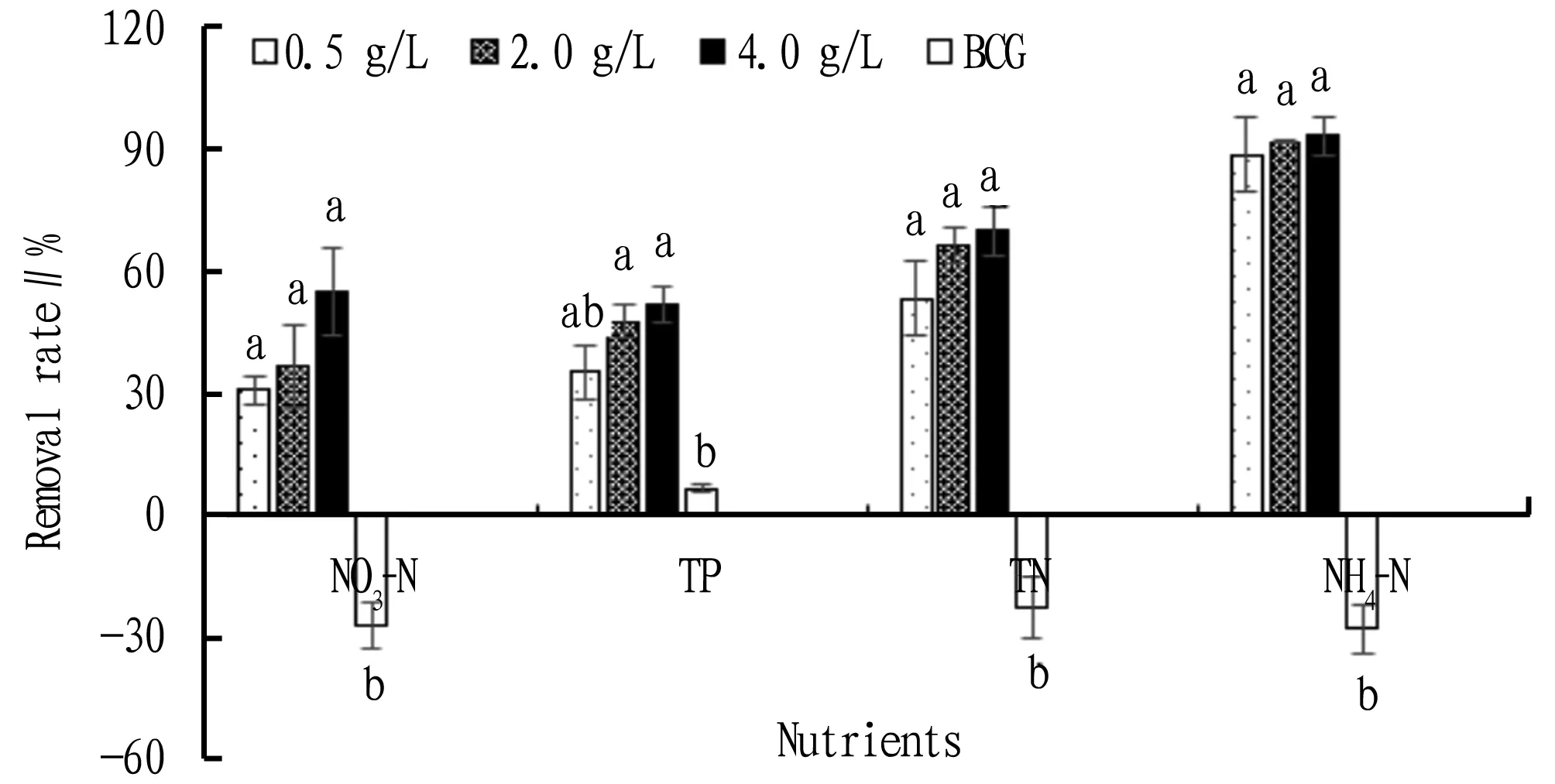
Note: If marked with the same letter, there is no significant difference (P>0.05); different letters indicate significant difference (P<0.05).
3.1.2
Removal effect ofG.
lichevoides
with different density on TP. The removal rate of TP inG.
lichevoides
with the culture density of 0.5, 2.0, 4.0 g/L and blank control group was 35.38%±6.67%, 47.94%±3.89%, 51.91%±4.57%, 6.86%±1.06%, respectively. There was a significant difference when the culture density was 2 and 4 g/L (P
<0.05), and the removal rate was the best when the culture density ofG.
lichevoides
was 4 g/L, which was significantly higher than that of the blank control group (P
<0.01).3.1.3
Removal effect ofG.
lichevoides
with different density on TN. The removal rate of TN inG.
lichevoides
with the culture density of 0.5, 2.0, 4.0 g/L and blank control group was 53.57%±8.98%, 66.68%±4.29%, 70.17%±6.1% and -22.57%±7.8%, respectively. One-way ANOVA showed that the removal rate of TN by algae with different density was significantly different. When the culture density ofG.
lichevoides
was 4 g/L, the removal rate was significantly higher than that of the blank control group and 0.5 g/L density group (P
<0.05).3.1.4
Removal effect of algae with different density on NH-N. The removal rate of NH-N inG.
lichevoides
with the culture density of 0.5, 2, 4 g/L and blank control group was 88.96±8.89%, 92.01%±0.38%, 93.45%±4.69% and -27.79%±6.15%, respectively. One-way ANOVA analysis showed that there was a significant difference in NH-N removal rate among different culture densities ofG.
lichevoides
, there was no significant difference when the algae culture density was 2 and 4 g/L (P
>0.05), but there was a significant difference between other groups (P
<0.01).From the above results, it was concluded that the nutrient salt removal effect ofG.
lichevoides
was positively correlated with its mass, and the nutrient salt removal rate was the highest when the culture density was 4 g/L, but it was not significantly different from the nutrient salt removal rate when the culture density was 2 g/L. Considering that the actual culture density of algae should not be too high, so the suitable culture density was determined to be 2 g/L.3.1.5
Biological characteristics of algae used in the experiment. The specific growth rate of algae was determined at the end of the experiment (Table 2). When the culture density ofG.
lichevoides
was 0.5, 2 and 4 g/L, the specific growth rate was 5.73%, 1.654% and 0.48%, respectively. The results showed that the specific growth rate ofG.
lichevoides
was significantly different among different culture densities, and the specific growth rate of the 0.5 g/L density group was significantly higher than that of the other two groups (P
<0.01).
Table 2 Biological indicator of the Gracilaria lichevoides used in experiment
3.2 Results of bivalves screening and density determination
3.2.1
Removal effect ofP.
laevis
with different culture density on nutrient salt. The results showed that different bivalves had different removal effects on different nutrient salts, even the same bivalves with different culture density had different removal effects on the same nutrient salts, but the effects were higher than those of the blank control group (Fig.2).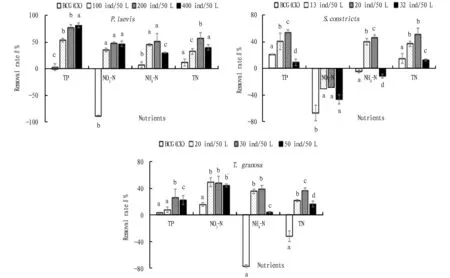
Note: If marked with the same letter, there is no significant difference (P>0.05); different letters indicate significant difference (P<0.05).
The TP removal rate of blank control group andP.
laevis
with culture density of 100, 200 and 400 ind/50 L was 2.83%±6.28%, 53.59%±3.51%, 77.62%±5.53% and 81.85%±4.65%, respectively. The TP removal rate ofP.
laevis
with culture density of 400 ind/50 L was significantly higher than that of the other three groups (P
<0.01). There was a significant difference between the blank control group and the other three groups (P
<0.05). The removal rate of NO-N in different density groups ofP.
laevis
was -89.60%±1.66%, 35.52%±3.58%, 48.31%±2.15% and 47.10%±5.01%, respectively, and the removal rate in the three culture density groups was significantly higher than that in the blank control group (P
<0.05). In the removal effect of NH-N, there was no significant difference between 100 ind/50 L and 200 ind/50 L density groups. The removal rate of NH-N in blank control group and other three density groups was 7.33±5.39%, 45.30%±1.98%, 50.98%±15.62% and 30.08%±0.92%, respectively. In the removal effect of TN, there was a very significant difference among the four groups (P
<0.01), and the removal rate of TN was 12.00%±6.63%, 32.57%±5.33%, 57.49%±10.78% and 40.40%±5.26%, respectively. It can be concluded that the TP removal efficiency ofP.
laevis
was the best when the culture density was 400 ind/50 L, but it was not significantly different from that of the 200 ind/50 L density group. In addition, when the culture density ofP.
laevis
was 200 ind/50 L, the removal rate of NO-N, NH-N and TN was the highest. Therefore, the best culture density ofP.
laevis
was 200 ind/50 L, and the purification effect of wastewater was the strongest.3.2.2
Removal effect ofS.
constricta
with different culture density on nutrient salt. The removal rate of TP in the blank control group andS.
constricta
with the culture density of 13, 20 and 32 ind/50 L was 20.91±0.52%, 40.70%±12.07%, 53.69%±3.96% and 9.32%±4.55%, respectively, and there were significant differences among the four groups (P
<0.01) (Fig.2). The removal rate of NO-N in four kinds of culture density groups was all negative: -66.67%±11.51%, -30.41%±1.49%, -28.45%±1.43%, and -45.87%±6.64%, respectively. Although it showed a certain degree of growth, it increased the fastest in the blank group, and it increased the slowest in the 20 ind/50 L density group, and the removal rate of NO-N in 20 and 13 ind/50 L density groups was significantly lower than in the blank control group (P
<0.01). The removal rate of NH-N in different culture density groups was -4.27%±1.93%, 39.94%±4.79%, 45.56%±4.93% and -11.24%±2.50%, respectively; the removal rate of TN was 14.88±7.07%, 36.99±3.50%, 50.96%±9.83% and 12.86%±1.37%, respectively. 13 and 20 ind/50 L groups were significantly different from blank control group and 32 ind/50 L group (P
<0.05). When the culture density ofS.
constricta
was 32 ind/50 L, the nutrient salt removal effect was the worst, which may be due to the fact that the ammonia excretion rate was higher than the removal rate. In the removal rate of NO-N, the 20 ind/50 L density group did not reduce its content, but increased the slowest among the four density groups, and the removal effect of the other three nutrient salts was the best. Therefore, the nutrient salt removal effect ofS.
constricta
was the best when the culture density was 20 ind/50 L.3.2.3
Removal effect ofT.
granosa
with different culture density on nutrient salt. The removal rate of TP inT.
granosa
with the culture density of 20, 30 and 50 ind/50 L and the blank control group was 7.79±4.21%, 26.04±12.65%, 22.16%±6.87% and 2.96%±1.15%, respectively. The results showed that there was no significant difference between the blank control group and the 20 ind/50 L density group (P
>0.05). The removal rate of NO-N inT.
granosa
with different culture density was 15.71±2.70%, 49.09%±6.75%, 47.49%±10.72% and 44.10%±2.24%, respectively. There was a significant difference between blank control group and other density groups (P
<0.05). The removal rate of NH-N was -77.35%±2.47%, 35.28%±3.16%, 38.85%±5.19% and 3.61%±1.21%, respectively, but there was no significant difference between 20 and 30 ind/50 L density groups (P
>0.05). There was a significant difference in the removal rate of TN among the four groups, which was -32.08%±7.90%, 21.38%±1.51%, 36.10%±4.03% and 16.21%±4.43%, respectively. The NH-N removal rate of 30 ind/50 L density group was significantly higher than that of other culture density groups except 20 ind/50 L density group. Therefore, the nutrient salt removal effect was the best when the culture density ofT.
granosa
was 30 ind/50 L.3.3 Results of integrated culture of bivalves and algae
As for the nutrient salt removal effect of integrated culture of bivalves and algae, the blank control group and the other three culture density groups all had a certain removal effect on TP, the removal rate of TP in the blank control group was 38.22%, and the removal rate of TP in 2, 4 and 8 ind/L+120 g was 70.16%, 78.45% and 86.18%, respectively (Fig.3). The results showed that there was a significant difference between the blank control group and the three culture density groups (P
<0.01), and the removal rate in the 8 ind/L+120 g culture group was significantly higher than in the 2 ind/L+120 g culture group (P
<0.05). The removal rate of TN in the blank control group and 2, 4 and 8 ind/L+120 g groups was 31.34%, 65.60%, 55.87% and 72.66%, respectively. The difference among the four groups was significant (P
<0.01), and the removal rate of NO-N was -13.34%, 33.01%, 47.26% and 51.85%, respectively. There was no significant difference between 2 ind/L+120 g culture group and 4 ind/L+120 g culture group (P
>0.05). The removal rate of NH-N in the blank control group was -137.04%. The removal rate of NH-N in the three culture density groups was 83.45%, 69.23% and 90.67%, respectively, and the difference among the four groups was significant (P
<0.05). The results showed that the best combination was 8 ind/LP.
laevis
and 120 gG.
lichevoides
, and the removal rate of nutrient salts was the highest. With the increase of culture density ofP.
laevis
, the specific growth rate ofG.
lichevoides
showed an increasing trend. In the three density groups of 2, 4 and 8 ind/L+120 g, the specific growth rate ofG.
lichevoides
was 2.69%, 2.77% and 3.20%, respectively.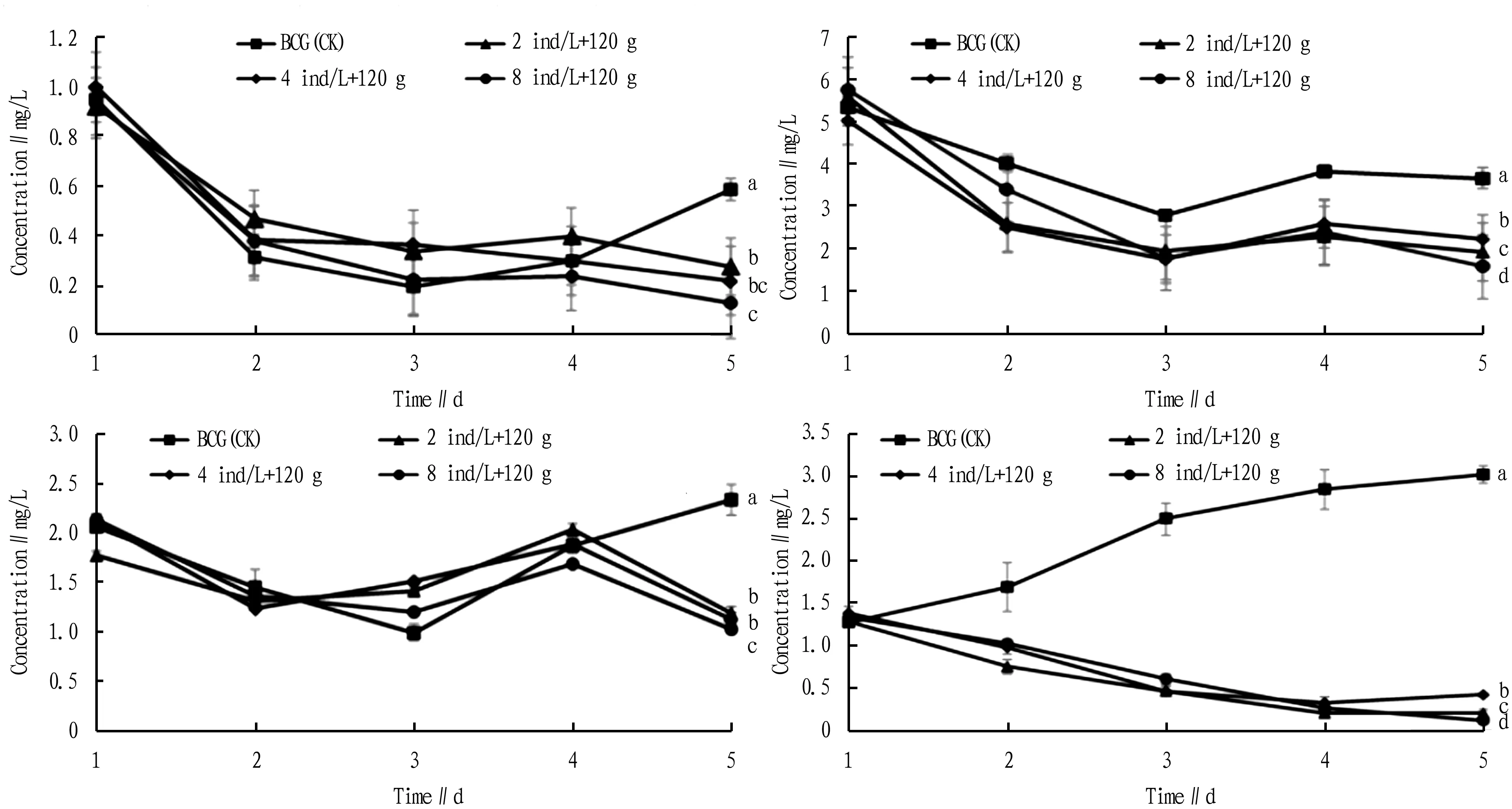
Note: If marked with the same letter, there is no significant difference (P>0.05); different letters indicate significant difference (P<0.05).
4 Discussion
4.1 Mechanism of purification of culture wastewater by macroalgae
The main factor to determine the efficiency of IMTA system is to choose the combination suitable for IMTA. The results of this study showed that macroalgae and three kinds of bivalves had a certain purification effect on nutrient salts, but there were significant differences in the purification effects of different kinds of filter-feeding bivalves, even bivalves and algae of the same species and different density.As an important primary producer in the ecosystem, macroalgae absorb dissolved COand nutrient salts through chlorophyll photosynthesis, and increase the dissolved oxygen (DO), to meet their own growth. The content of N in water directly affects the survival and growth of cultured organisms, while N in culture water mainly exists in the form of NH-N, NO-N and NO-N. In this experiment, the removal rate of NH-N inG.
lichevoides
was significantly higher than that in NO-N and TP, and the maximum rate could reach 93.54%±4.69%. NH-N and NO-N are considered to be the most important nitrogen sources for the growth of macroalgae, but it is generally believed that NH-N is easier to absorb. After NH-N is depleted, algae begin to use NO-N, and some scholars think that NH-N can be directly absorbed by algae to synthesize N-containing organic compounds such as amino acids by ammonia transfer. Among the four nutrient salts, the removal rate of NO-N is relatively low, which may be related to the fact that algae do not produce active nitrate reductase and can not directly absorb nitrate in water.In addition, the concentration of N and P in water, the ratio of N to P and the concentration of phosphate in G. parvispora also affect the absorption of P in water.G.
lichevoides
increased during the experiment, but there was no significant difference in specific growth rate between 2 and 4 g/L (P
>0.05). Therefore, in terms of purification capacity and specific growth rate, the best culture density ofG.
lichevoides
was 2 g/L.4.2 Treatment of wastewater from shrimp culture with filter-feeding bivalves
Filter-feeding bivalves mainly filter out the plankton and organic debris in the water body, reduce the suspended particles and improve the transparency, so as to achieve the purpose of purifying water quality and achieving the growth of their own biomass. Filter-feeding bivalves are located in the middle link of the ecosystem, which regulate the cycle of nutrient salts and affect the level of nutrient salts, but they will also produce a large number of faeces and other substances in the process of self-culture and react to the water environment. Therefore, how to achieve the best effect of water purification and maximize economic benefits under the maximum culture density is the key problem to be solved in ecological integrated culture at present. The study shows that the maximum density (biomass or number)is the best culture density when the filtration rate of bivalvesis greater than its own excretion rate. The results showed that in terms of the removal rate of NO-N,S.
constricta
<T.
granosa
<P.
laevis
; in terms of the removal rate of other three nutrient salts,T.
granosa
<S.
constricta
<P.
laevis
. In addition,P.
laevis
has the characteristics of fast growth, wide adaptability, strong tolerance and reproduction twice a year, so it is an ideal filter-feeding bivalve for purifying water.4.3 Determination of the integrated culture ratio of bivalves and algae
Optimizing the integrated culture system can purify the water quality, improve the problem of pond sediment, reduce the culture cost, and improve the survival rate and flesh quality of organisms under integrated culture. However, in a specific environment, the culture capacity is certain, and in a certain capacity, the most important thing is to maintain the best proportion of integrated culture for a long time. The results showed that in integrated culture, 8 ind/LP.
laevis
+120 gG.
lichevoides
was the best combination, the wet weight ratio was 1∶1, and the TN and NH-N removal rate was significantly higher than that of other groups. The removal rate of NO-N and TP was significantly higher than that of blank group and 4 ind/L+120 g density group. The results are also consistent with the related studies of other researchers. Studies by Hu Haiyan and others have shown that integrated culture with a fish-algae ratio of 1∶1 is reasonable. If the algae culture density is too low, the nutrient salt content in the water body is too high to achieve the ideal effect, and if the culture density is high, the algae absorb a lot of nutrient salts, affecting the normal growth of fish. Sun Weiet
al.
found that when the culture ratio of Gracilaria lemaneiformis and Meretrix meretrix is 1∶1, the dry weight and survival rate of Meretrix meretrix will be increased. In addition, the higher the culture density ofP.
laevis
, the higher the growth rate ofG.
lichevoides
. Compared with the previous monoculture of G. parvispora with the same culture density, the specific growth rate increased significantly. Nelson and others use shrimp pond wastewater to cultivate G. parvispora, a macroalgae, which has good quality and fast growth, and its relative growth rates (RGRS) can reach 4.7%/d. The transparency of water body is an important factor to determine the photosynthesis of macroalgae.P.
laevis
produces biological sedimentation through filter-feeding function, having an impact on the structure and function of plankton, particulate organic matter and ecosystem in the water body, and improves the transparency of the water body.G.
lichevoides
provides sufficient oxygen toP.
laevis
through photosynthesis to promote its growth. The nutrient salts produced by the metabolism ofP.
laevis
provide nutrients forG.
lichevoides
to purify the water body, and the two can reduce the problem of eutrophication of aquaculture water body through ecological complementarity, so as to maximize the ecological and economic benefits. When Msuya used G. parvispora to treat wastewater from fish ponds, it was found that macroalgae could remove more nutrient salts than those needed for growth, and store the excess in the body.5 Conclusions
To sum up, the culture density ofG.
lichevoides
was positively correlated with its removal rate of nutrient salts, but negatively correlated with its own specific growth rate. IfG.
lichevoides
was cultured alone, the best culture density was 4 g/L, and the best culture density was 2 g/L in integrated culture.P.
laevis
has stronger ability to purify water than the other two species of bivalves, and its reproductive cycle is short, and it can reach sexual maturity in 4-6 months. Therefore,P.
laevis
is an ideal candidate species, and in the integrated culture of bivalves and algae, the combination of 8 ind/LP.
laevis
and 2 gG.
lichevoides
had the best wastewater treatment ability. This study provides a strong theoretical basis for integrated culture of L. vannamei, filter-feeding bivalves and macroalgae at multi-nutrient levels in Zhejiang Province.杂志排行
Asian Agricultural Research的其它文章
- Technical Measures for High Quality and High Yield of Free-range Sows in Rural Areas
- Site Pollution Remediation and Its Technology
- Thoughts on Science and Technology Service in Provincial Agricultural Research Institutes under the New Normal: Taking Changli Institute of Pomology of Hebei Academy of Agriculture and Forestry Sciences as an Example
- Difficulties and Countermeasures in Harmless Treatment of Infected Pig Carcasses
- Survey and Analysis on Present Situation of Biological Experiment Teaching in Some Middle Schools in Yangjiang Area
- Development of Customized Production Machine for Flue-cured Tobacco Formula Nutritional Soil
